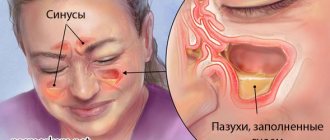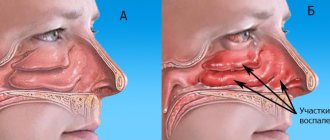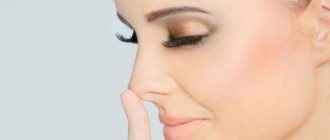Contraindications for nose surgery
For rhinoplasty, as for any other operation, there are many contraindications. The first thing you should pay attention to is that nose surgery, like most other plastic surgeries, is performed only on adults.
The main contraindications include insufficiency of the digestive, respiratory, urinary and cardiovascular systems. People suffering from diabetes, mental disorders and oncology are not recommended to undergo rhinoplasty.
Poor blood clotting and collagen systems will also become an obstacle. Plastic surgery is strictly not recommended for people over 40 years old. Since the regeneration of their tissues is significantly lower.
However, the above factors are not always a problem. The surgeon approaches rhinoplasty individually. It is the doctor who will determine contraindications and the possibility of surgical intervention.
Plastic surgery of the nasal septum as a current solution to breathing problems
Septoplasty is an operation to correct the nasal septum. It is most often done to eliminate breathing difficulties associated with septal deformation. The operation is carried out quickly, on an outpatient basis and significantly facilitates breathing, relieves ongoing sinusitis and rhinitis.
The septum itself is a plate of bone and cartilage, covered on both sides with mucous membrane. An ideal nasal septum (which runs exactly down the center and divides the face into two symmetrical parts) is actually rare. Most often, it becomes bent during the growth of the body, sometimes due to injury. If curvature occurs, breathing becomes difficult and less air flows in.
The septum may deviate in any direction from the center, and then nasal obstruction forms on this side. There are cases when the septum is deformed in two places in the shape of the letter “S”. In this case, obstruction appears on both sides.
Most often, a person does not even notice a deformation of the nasal septum, but complains of breathing problems. Only in some cases the curvatures are noticeable at a quick glance. In most cases, changes in the structure of the septum can only be detected through instrumental examination.
On this topic
- Rhinoplasty
What is rhinoseptoplasty
- Editorial board of Plasticology.ru
- July 8, 2020
After diagnosis, septoplasty is prescribed. The surgeon operates from the inside, through the nostrils, and therefore no cosmetic defects will be visible. Rhinoplasty can also be performed along with septoplasty.
This operation is aimed at changing the appearance of the nose and is done for aesthetic reasons. It can be either a doctor’s indication (when a deviated septum leads to a violation of the very shape of the nose), or the personal desire of the patient.
Types of rhinoplasty
Many people have a question, what types of rhinoplasty are there? It would seem, the nose, what to take from it? However, there are many types, and each is aimed at a separate part or function. The versatility also lies in the fact that certain operations affect different types of tissue (bone, cartilage).
tip of the nose
Nasal tip surgery is one of the most difficult rhinoplasty operations. Since it is this area that makes a big contribution to the appearance of any person. Surgeries on the tip of the nose are performed exclusively by surgeons with many years of experience. During the operation, external defects of a given area, shape and profile irregularities are corrected.
Base of the nose
Plastic surgery of the base of the nose is responsible for reducing the width of the nostrils. The intervention requires extreme care from the rhinoplasty surgeon. Since any wrong movement can lead to the formation of scars. In rare cases, this intervention is used in combination with others.
Columella correction
For those who don't know, the columella is a section of the septum of the nasal cavity made up of skin. She separates her nostrils. Columella can have different shapes and is very noticeable. With the help of surgery it can be made shorter or narrower.
Nose shape
Rhinoplasty allows you to correct the shape, get rid of the annoying hump and straighten the axis. This intervention affects cartilage and bone tissue. The operation will restore the broken nose to its original appearance.
Rhinoseptoplasty
This service allows you to solve the problem of snoring if it is caused by a deviated nasal septum. This makes breathing easier.
Grafting
Changing the shape of the nose using cartilage transplantation. Tissue is often taken from the patient's ribs, ears, and septum. This operation is very serious, as the structure of the organ completely changes.
Reconstructive rhinoplasty
During the doctor’s intervention, the problem of correcting errors made during other manipulations is solved. Restoration of burned skin areas and other injuries is carried out.
Conchotomy
It is divided into laser and conventional. During surgery, the hypertrophied area of the mucous membrane in the nasal turbinates is completely or partially removed. This intervention is performed when there is difficulty breathing.
Electrocoagulation
In case of moderate hypertrophy, an electric current is directed to the nasal turbinates. It is safe for the human body. And the procedure itself occurs without surgical intervention.
Contour plastic
A dose of hyaluronic acid injection is administered. Due to this, subtle external defects are hidden.
Operation stages
Regardless of what type of rhinoplasty the patient and the plastic surgeon decide on, nose correction has mandatory steps.
These include:
- Anesthesia. The correction is most often carried out under general anesthesia, but it can also be carried out under local anesthesia - it all depends on the scope of the intervention. If superficial rhinoplasty is planned, the duration of which is insignificant, then local anesthesia will be sufficient.
- Access to the surgical field. At this stage, all the necessary incisions are made, according to the chosen type of operation - open or closed nose correction.
- Direct correction of all deficiencies. Depending on the type of operation, the doctor’s actions may differ radically:
- Correction of the tip of the nose. The operation is most often carried out through internal access. All interventions are performed without affecting the bone structures - partial rhinoplasty. The main techniques are excision, movement and compression of cartilage.
- High nose with a hump. The doctor usually excises the hump using a chisel and rasp. The back is cut down if necessary, and the side bones are separated and placed in a new position.
- Correction of “saddleback”. This is done through internal incisions. For good results, implants or grafts can be used. Also, this intervention is often combined with plastic surgery of the tip of the nose.
- Plastic base and wings. For a good result, the doctor excises some soft tissue, and the wings are pulled to the middle and sutures are applied.
- Correction of curvatures. One of the most complex types of interventions. In order to achieve symmetry, the doctor excises sections of the septum in places of maximum curvature. The surgeon must constantly remember the function of this part of the nose - supporting, which is why it is important not to overdo it in removal.
- Columella correction. The operation can be performed either to increase or decrease a given part, or even simply to correct the shape. To achieve the goal, both excision and transplantation techniques can be used. Surgery on the tip of the nose can also help, because its appearance greatly affects the overall picture.
- Width correction. To achieve a better result, the doctor may resort to osteotomy techniques and work with cartilage tissue.
- Correction of a large and long nose. This intervention most often requires revision rhinoplasty. The thing is that even using all correction techniques, affecting all parts of the nose, it can be difficult to achieve results at the same time.
- Contour plastic. Most often, doctors resort to implants, but now there are fillers on the market - gels that allow plastic surgery without incisions and scars.
- Packing of the nasal passages, applying a plaster bandage to the tip and the entire nose. These measures are provided to prevent unwanted deformations. Typically, tampons are removed after 48 to 72 hours, while the bandage may remain on the face longer.
- Extract. With some types of rhinoplasty, the patient goes home already 24 hours after the operation, but visits the clinic and the doctor to monitor the healing process. In difficult cases, the patient remains in the clinic until the doctor deems it safe for him to remain at home.
Methods
For these purposes, it is customary to divide operations into two methods: closed and open. In the open method everything is extremely clear. The operation is carried out by opening the soft tissues for plastic surgery.
With the closed method, the intervention occurs through the surface using innovative technologies. It is important to understand that the cost of such operations is significantly higher. And not every type can be done using a closed method.
Rehabilitation
Depending on the type of surgery, the rehabilitation process may vary. For rhinoplasty, which refers to cosmetology, this takes several hours. In exceptional cases, complete recovery takes a couple of days.
With surgical methods, the patient will experience swelling of the nose and eye area. They will begin to go away only on the 7th day, after the plaster is removed. In exceptional cases, a plaster cast is applied for 10 days.
The rehabilitation process after nose surgery is individual. Depending on the patient’s age, type and complexity of the operation, recovery may take up to a month. Sometimes longer.
Where and how is septum correction performed?
Nasal septum defects are corrected through surgery. The operation, with the exception of emergency cases, is planned, classified as plastic and can be performed in most ENT hospitals.
The duration of the procedure is less than 30 minutes. Its purpose is to remove the curved area. General anesthesia is most often not required, but local anesthesia is practiced. Upon completion of the operation, cotton swabs are inserted into the patient’s nasal cavity, which should remain there for 2 days.
Modern rhinoplasty offers several options for how a crooked nose can be corrected. The operation for resection of the septum consists in the fact that first all the mucous membranes are peeled off, the defective section of cartilage is removed, and the soft tissue is returned to its place. Such manipulations are easily carried out in most clinics, they are free, but the recovery period after them is the longest.
A more modern way to eliminate curvature is septum plastic surgery. Its peculiarity is that the mucous membrane peels off only on one side. In this case, the defective section of cartilage is not removed, but rather leveled. The advantage of plastic surgery is the shortened adaptation period, but it is not performed in all medical institutions and is usually paid for. True, when it comes to health, few people will think about how much nose surgery costs. Moreover, you will only have to spend 3 thousand rubles.
Finally, the most progressive way to eliminate nasal septum defects is thermal plastic surgery. It was first successfully carried out in 1998. The whole point of the process is to heat the cartilage to a temperature at which it becomes elastic, and further align the septum. Thermal plastic surgery is a completely bloodless method. The patient does not require additional recovery time after the procedure. Unfortunately, due to the unavailability of special equipment, this method is used only in large clinics.










